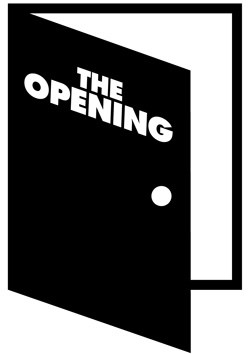
|
THE OPENING is all about introducing the fascinating, quirky and wonderful people working in and around the visual arts in Vancouver. Each week, we'll feature an artist, collective, curator or administrator to delve deep into who and what makes art happen! |
Brad Chernoff and Kaycee Marchant operate one of the premiere framing shops in Vancouver - Chernoff Fine Art. Artists, collectors and everyone in between come to them for their commitment to the protection of their art... but also because they are just plain great people. Framing is a notoriously waste-creating practice mostly due to the packaging that all the materials arrive in, and Marchant has worked hard at finding homes for everything from high-code plastic tubes that carry spacers, to the foam that moulding often comes wrapped in. I visited them as their exhibition with Angus Ferguson was winding down.
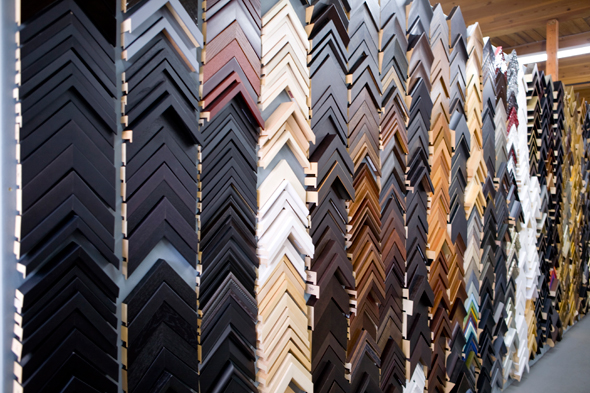
A selection of the hundreds of frame samples velcro'd to their wall
How did you begin framing?
Brad Chernoff: I came out of Emily Carr in 1987 and started framing for some of my artist friends like Rodney Graham and Neil Wedman. I just saw a need for conservation framing at the time and there weren’t a lot of people doing it. Just from word of mouth it basically developed from there. That was 25 years ago.
I know you specialize in conservation framing – no economy, no pre-made frames - that’s obviously a conscious decision.BC: I think so. We’ve always dealt with more original artwork and more fine art, and the conservation element has always been quite important.
Kaycee Marchant: It also makes our job more interesting. We get to see beautiful things come through. The more economy level framing, which is where I learned how to frame was incredibly boring. You just see poster after poster, Klimt The Kiss after Klimt The Kiss. Why buy a poster when you can go get some fabulous Emily Carr grad show artwork for a similar or only slightly higher price and frame it up.
BC: It’s funny - I came across Klimt original prints. I ended up buying a portfolio of Klimt prints from 1907, and they did have a The Kiss print in it, and all the prints happened to be originals that Klimt had overseen himself. I’ve worked with antique pieces as well as antique prints.
How does an average order work?
KM: We work by appointment. We’ve never done any advertising, so all of the people we have relations with are either referrals from other people or people that we have a long standing with. And they ring in, you know I have this piece, can I come in and see you. We set up an appointment and they come in. The reason for that is we like to both be present for the consultation. We both have different ideas but we both think the same way, so we can help to fine tune the consultation process and the design. There are hundreds and hundreds of choices, so we’re able to sift through that.
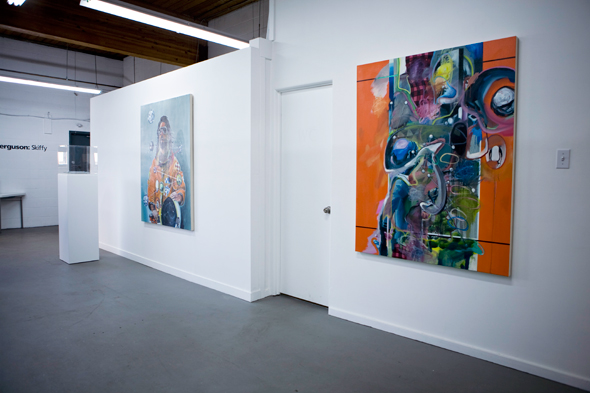
Installation view 'Angus Ferguson: Skiffy'
BC: We have a certain look that generally we kind of do, which is a minimal museum look.
KM: Though of course we’ve done everything under the sun.
BC: That’s true. But the majority of work we’ve done, the frame fades away behind the art itself. We’re trying to show the art as best we can.
KM: They take those thoughts away, and we will usually work out a price for them then and there, take photographs and send them their options over email. When they approve, we’ll proceed with the work – order the materials, do the framing. They come in, say it’s okay, pick it up and go! Sometimes we will even arrange to deliver and install it for them. Doing it for so long, it has just become an easy process.
So the only portion of your ordering that you do by computer is just when you email someone their options – you don’t have an online order system like a corporate framing store.
KM: No we don’t. Everything has to be done in a very personal way here. We don’t have anything automated or mass-produced or volume or anything like that. Every single piece is hand selected and worked on, one item at a time.
When did you make the decision to also have an art gallery in the space? Or has it always been a part of your business?
BC: In my original business in the 1980s I had a gallery in my shop as well, and I enjoyed that aspect of it with the framing. I knew so many artists that I could have shows with. It’s really gone back quite a long ways. Over the years we’ve always tried to do small exhibits.
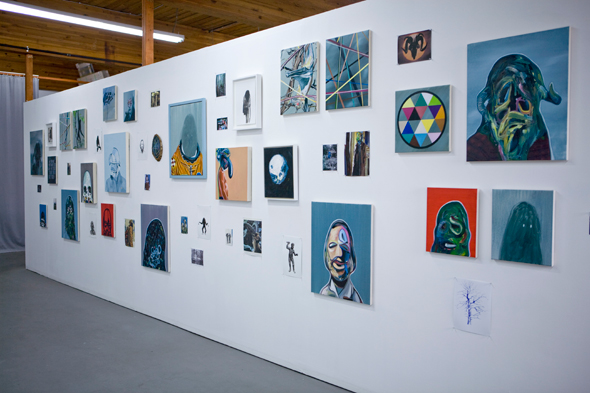
Installation view 'Angus Ferguson: Skiffy'
KM: That was one of Brad's first businesses. But then when rent started going up downtown, we had to move into a space that wouldn’t really allow for that kind of thing anymore. So that whole exhibition portion had to be stopped, and we just had a few pieces up on the walls that were for sale. But then when we moved to this space 3 ½ years ago, the opportunity came up to have an exhibition space. Originally we though about having a gallery space and selling work and trying to generate income that way, but a friend advised us that we really shouldn’t do that. And you know, it made perfect sense, because we would have been competing with the very people that we are encouraging to come to us to work with.
BC: I see it as a preview space for artists. It’s a starting point. From here some artists have found galleries and then other galleries have found them. It’s a nice little introductory space.
KM: One of the other things about the exhibition space is that we choose what goes in it. We do have people call and say ‘Oh I’m an artist and I’d like to show my work.’ We say thank you, no thank you, only because we could start getting hundreds of submissions. We don’t represent anybody. We just show art we love.
BC: We don’t take a commission off the space.
KM: We’re trying to support friends who we feel need more exposure, or just people that we love and want to support.
BC: It’s a social part of the business. Having openings is fun. When we do it with Catriona’s [Catriona Jeffries Gallery] openings it’s great, we get a lot of people through. It’s worked out quite well.
KM: In terms of a long-term goal, we would like to develop more art sales for the business. For people to start to get to know that coming to us for art is also a possibility, not just for framing. That is setting us up for the development of our business down the road. Brad always tackles all of the art sales and I’m more the manager of the framing end of things. We’d like to flip the scale on our income- the framing dominates right now but we’d like to even that out a little bit. So Brad works hard at trying to find and buy choice pieces of art that he will flip in a few years time. He likes doing it, it’s a fun part of the job that makes our working life more enjoyable.
So what kind of art do you look for?
KM: Brad just found a book of 50 Japanese colourized photographs that are so beautiful. He’ll take that, conserve the book, frame each piece and try to sell those. That’s what he did with the Klimt portfolio too. It’s the finding of the pieces – it has to be the right thing. Most are prints, we rarely sell originals.
So do you only sell in Vancouver or do you also sell online?
BC: We’ve done some online sales.
KM: We’re not very computer saavy.
BC: We’re going to be upgrading.
KM: Our website isn’t up to snuff. We try to put the art that we have for sale up, but sometimes it’s six months later and we think, oh, we should do that!
BC: For any gallery it is key to be online. We’ve gotten a lot of sales because of online advertisements, things like eBay and that.
KM: You know, it’s basically just Brad and I working here. We have three part-time staff – one is an office administrator and two of them are production assistants. So we pretty much cover everything. We’ve really spread ourselves out over a lot of different responsibilities, and you just can’t be an expert in everything. The website, important as it is, is not our first priority.
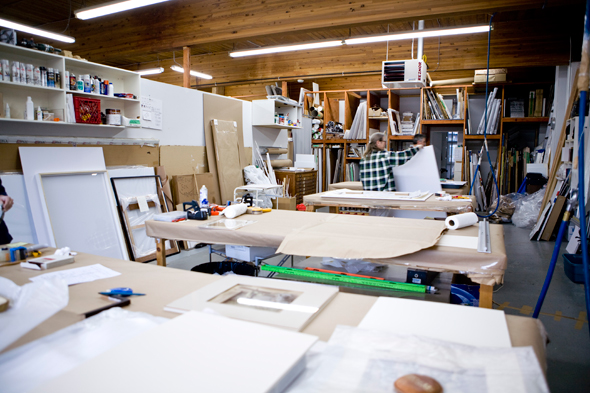
Where all the framing happens!
BC: Generally our whole thing is conserving art and framing it properly and making sure that it’s not damaging anything. Everything should be reversible in a way. More and more we are using conservation glass on everything and things like that. Some of the pieces we are framing are investments for clients and they are quite valuable. So we want to make sure they are done carefully.
What’s the most interesting thing you’ve framed?
BC: There have been challenges over the years! There was a Hermes scarf…
What was a challenge about it?
KM: It was the way it was presented – just coming up with a solution with the client and then making it look absolutely perfect was a bit of a challenge, because it was a fabric piece.
BC: One of the most interesting things was the black jack table from the casino. It was from a Las Vegas casino. We had to put it together, mount it, glue the chips and cards…
KM: Really, super, not what we would usually do, but it was fun and definitely interesting. We also framed the giant scroll in the Shangri-La lobby – that was a challenge just due to the sheer size!
BC: The 1,000 broccoli prints by Martin Creed was the biggest thing we’ve ever done in volume. When you even think of 100 frames, that’s a lot, but 1,000….
KM: One thousand is even hard to visualize! When you start stacking up the frames, you realize that it would probably fill this entire room from floor to ceiling.
The other job that was really fun was also for Bob [Rennie] - the reclaimed fir framing project. That involved a lot of different parts and pieces, and other craftspeople. It was really lovely to know where the moulding had originated from and then turning into something completely different. It was fascinating, rewarding and really interesting to work on.
Even some pieces that have real monetary value, even if they are not necessarily interesting to look at, they are just interesting knowing that they are worth that much money. It’s a little terrifying, but you just have to let it roll off your back and get on with it.
Even just to get to touch something that has been given that kind of value – how many people really get to do that?
KM: Just being in the same room as some of these works… how lucky is that?
BC: We’ve done Group of Seven paintings, and important Canadian art. I did a lot of early Rodney [Graham] work when he wasn’t as well known.
KM: It doesn’t always go well with the clients either – with every business, there are disasters! You have to tackle those and assess the route to take. Are you firing a customer when you do this or are you bending over backwards to make this better? These are always issues that crop up now and again and always present a challenge. We’re manager, production, even the janitor of the business – these things keep it interesting.
So say I have an 11x14” photograph, and I want to put conservation glass, one mat and a frame on it. How much would that cost, from maybe a low-end frame to a high-end frame?
KM: The first thing we try to figure out with a client is whether 11x14” is the final size or if it is just the size of the piece. So if it’s the size of the piece, then we try to determine what kind of feel you are going for – rustic, modern, etc. So once we have that figured out we can give kind of a loose estimate.
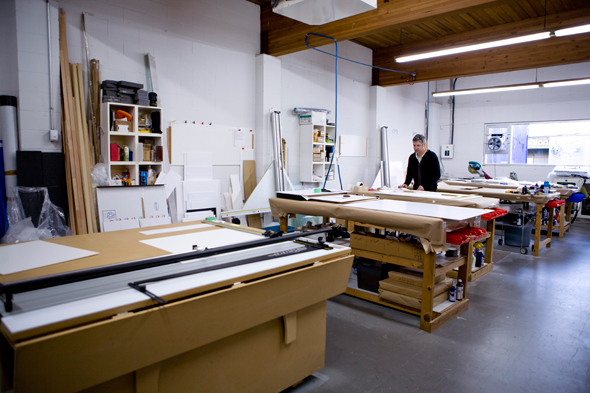
Brad hard at work
BC: We definitely have gallery frames that are affordable that we use for exhibition framing all the time, where the codes are quite low and they are reasonable. Prices can vary so drastically from each frame manufacturer though.
KM: I would say, with us, you could probably frame that anywhere from $90-$400. I think that’s very loose, but covering a real gamut of frame choices. That’s the big obstacle in framing to determining price. All the other materials in framing are priced fairly similarly, and all the other competitors in framing are going to be charging roughly the same prices for the glass, the labour, the little materials. But the frame itself, if you’re not comparing the exact same frame at the exact same price, you will never be able to compare prices between framers.BC: Framing is a shrinking market in general. You see less and less framing shops around as time goes on.
KM: Our niche is getting to know our clients and getting to know their expectations. We know what a client’s style is like, we know what their house looks like because we’ve been there – we just try if we can to incorporate everything together.
All photographs by Anne Cottingham


